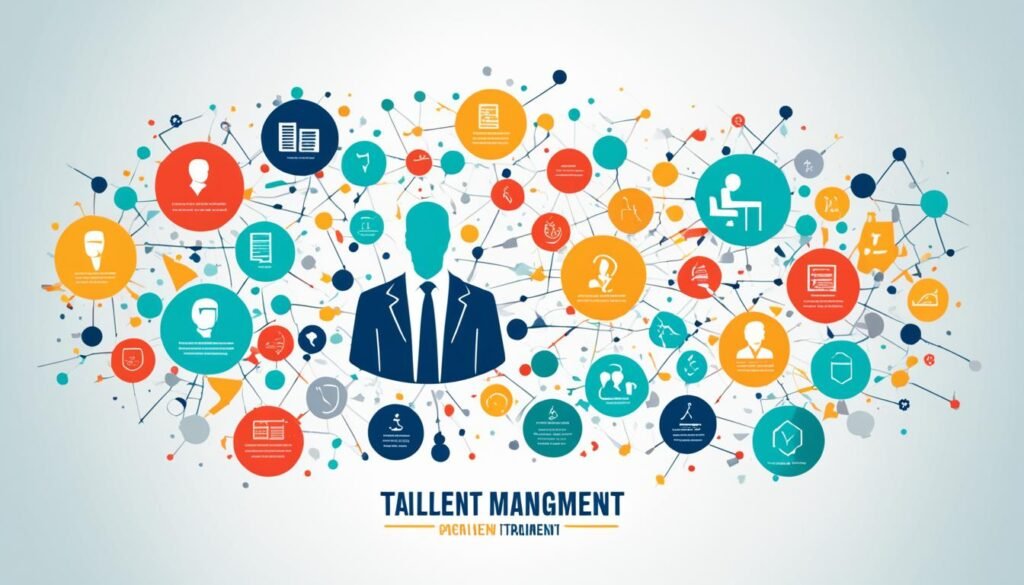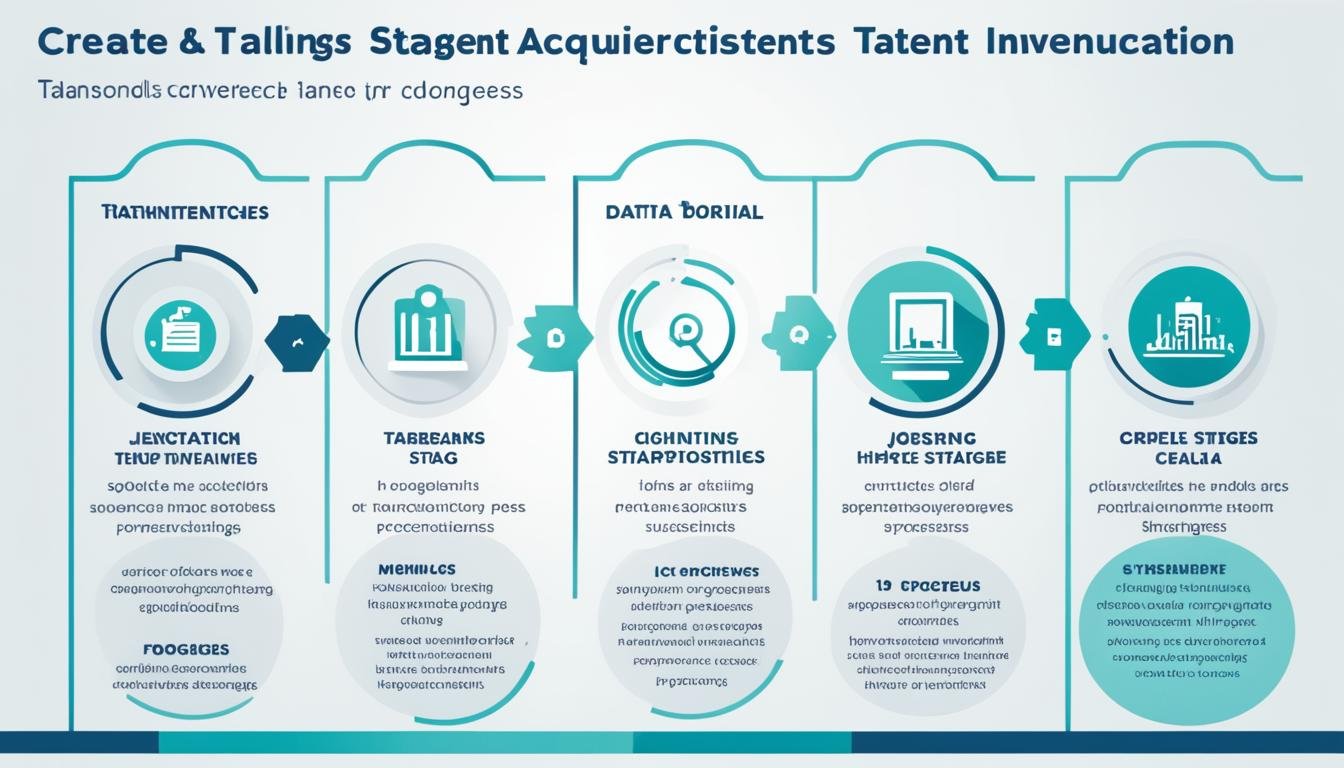What is involved in comprehensive talent management?
Talent management is key for a company’s success. It includes finding the right people to train and keep. By caring for talent from the beginning to the end of their time with the company, they grow and stay.
This article will look at talent management’s parts. It will show why using HR technology is important. We’ll also share tips and ways to measure how well your talent management plan works.
Key Takeaways:
- Effective talent management can significantly enhance organizational revenue and profit.
- Talent management involves various components, including talent acquisition, employee development, and performance management.
- Using HR technology in talent management can streamline processes and improve outcomes.
- Implementing best practices and measuring key metrics are crucial for successful talent management.
- Investing in talent management leads to improved employee engagement, retention, and overall organizational success.
The Definition of Talent Management
Talent management means using the right people to help a company grow. It’s all about finding and keeping the best employees. By using various methods, companies attract, retain, and develop their top talents.
Talent management features spotting the most promising individuals and helping them grow in their careers. This approach ensures companies always have skilled and committed workers ready to help them succeed in the long run.
But what exactly does talent management entail? Let’s take a closer look at the key components:
The Components of Talent Management
- Learning and Development: This part focuses on giving employees chances to improve their skills. They get access to things like training and mentoring. These efforts help employees perform better and advance in their careers.
- Employee Engagement and Retention: Happy employees often stick with a company. Talent management aims to keep them engaged. This is achieved through creating a great workplace, acknowledging achievements, and helping maintain a good life-work balance.
- Talent Mobility: This means letting employees move and grow within the company. It includes promotions or trying out new roles. Doing this allows employees to bring in fresh skills and perspectives to different parts of the organization.
The exact meaning and elements of talent management can differ from one company to another. Each company might use its approach that fits its goals and values best.
Companies can attract and keep great people by adopting a complete talent management strategy. By focusing on these components, they can fill their teams with innovative, productive, and successful individuals.
Key Benefits of Talent Management
Talent management helps organizations with:
- Getting and keeping talented staff
- Making employees more engaged and satisfied
- Building a skilled and capable workforce
- Planning for the future with good leaders
- Boosting how well the company does and its competitiveness
Investing in talent management makes for a workplace that treasures and grows its people. This leads to a more committed and efficient team.
Pillar 1: Employee Development
Employee development is key in managing talent well. It means giving workers chances to grow their skills. This helps them add to the company’s achievements. When a company helps its people grow, they stay longer, are happier in their jobs, and do better work.
The Importance of Employee Development
Taking care of how employees grow is crucial. It links personal and company goals. When growth is encouraged, people get excited to do their best. They see opportunities to do more and go further in their careers with their company’s support.
Good programs to help employees grow do many things for a company:
- They make workers better at what they do. New skills mean they can help the company more.
- They keep ideas fresh. People who learn a lot are more likely to think of new ways to do things.
- They make workers happy. Knowing their company wants to help them grow makes them more satisfied and loyal.
- They prepare for the future. Growing workers now means the company has ready leaders later on.
Performance Management and Employee Development
Tracking how employees do is very important for their growth. It’s about setting goals and helping them meet these goals. This makes sure workers and the company move forward.
With this system, a company can help each employee see how they help the bigger picture. Each one understands their role in making the company successful. This gives everyone a clear, common direction.
| Benefits of Employee Development |
|---|
| Enhanced employee engagement and motivation |
| Improved employee performance and productivity |
| Increased employee satisfaction and retention |
| Reduced skills gaps and increased workforce capability |
| Support for succession planning and leadership development |
Investing in helping workers grow helps everyone. Workers get better chances in their jobs. Companies get people who can do more and want to make the company better.
Pillar 2: Employee Engagement and Retention
Employee engagement and keeping team members are crucial in talent management. When employees are active and feel valued, they do better work. This boosts a company’s overall success and keeps their best people around. Building a positive culture stands out as one of the top priorities for any growing business.
Happy and motivated employees do more and better work. When a company values them and their ideas, they’re more engaged. Engaging employees can happen by celebrating success, offering room for personal growth, and by showing they matter.
“Engaged employees go the extra mile, bringing their best selves to work each day.”
Good communication is key to engaging employees. Using tools like modern HR tech helps keep everyone on the same page. It lets workers feel heard and valued, which is central to their engagement.
Keeping a good team is as important as finding one. Companies save money and knowledge by stopping their best from leaving.
“Retention starts with hiring well. But, it’s the work put into keeping and growing talent that holds them.”
Having clear paths for careers and a good pay is part of keeping great people. Add in programs that help them learn and grow, and you show they have a future with you. This builds trust and loyalty.
By focusing on engaging and keeping employees, companies succeed. The harder their team works, the better the whole team does.
Pillar 3: Talent Mobility
Talent mobility is pivotal in managing talent well. It involves moving employees within a company, both up and across. This helps people grow and lets the company benefit from their skills fully.
Good mobility programs let workers try new jobs. They learn new things which helps them grow, and this growth helps the company succeed too.
Focus on internal mobility helps workers deal with new challenges. It joins growth and keeping employees happy, because those learning new skills tend to stay and help the company’s big goals.
Benefits of Talent Mobility:
- Enhanced employee engagement and satisfaction
- Development of a diverse skill set
- Increased productivity and innovation
- Reduced employee turnover
- Creation of a talent pipeline for future leadership positions
To support mobility, companies should follow certain steps. They should make a culture that encourages moving within, show clear career paths, and allow employees to go after new roles easily.
HR tech plays a key role in making mobility work. Having good HR systems makes it simpler for everyone. This way, employees can find new posts and bosses can spot who’s ready for more.
When companies give mobility high priority, they win. They help their staff grow, keeping the best people around. This builds a workplace that’s always growing and learning.
Avature’s Approach to Talent Management: A Seamless SaaS Ecosystem
Avature leads in providing innovative software for talent management. Their SaaS ecosystem helps organizations fine-tune and improve their talent processes. They do this with cutting-edge HR tech.
Their software has many features. It supports everything from finding new talent to boosting current employees. This all-in-one solution makes it easier to find, grow, and keep talented people.
Seamless Integration and Data-driven Insights
Avature’s big win? Combining data and tools smoothly. They create a unified platform that ends data isolation. With a clear view of their talent scene, companies can make smarter decisions based on up-to-date data.
Also, Avature’s software helps teams work together better. It connects employees, managers, and HR. This strengthens teamwork and makes talent management more effective.
A Personalized Employee Experience
Not every organization is the same. Avature knows that. Their software lets companies shape the employee experience to fit their goals. This includes custom onboarding and learning plans. It boosts how engaged and loyal employees are.
Customer Success and Support
“Avature’s customer success team is dedicated to helping organizations maximize the value of their talent management software,” says Jane Davis, HR Director at a global tech company. “Their support and expertise have been instrumental in optimizing our talent management processes and driving better outcomes for our organization.”
Avature is all about helping their customers thrive. They offer great support from implementation to ongoing use. Their experts are always ready to help. They guide through the entire talent management process.
Why is Talent Management Important?
Talent management is key to a company’s success. Studies show linking managing talent well with better overall performance. This makes it a top priority for businesses. By focusing on talent, companies set the stage for their success and stay ahead in the market.
This strategy covers ways to attract and keep top talent. It aims to boost how engaged and productive employees are and to encourage creativity. Basically, it helps take care of employees from when they join to when they leave.
When companies invest in managing talent, they can bring in and keep skilled professionals. These people help the organization grow and do better. This means companies with top talents can push ahead and be more competitive.
Better talent management also increases how satisfied and motivated employees are. When people feel valued and empowered, they do more for their jobs and the company. They help achieve company goals and build a positive work culture.
“Effective talent management is essential for organizations looking to outperform their competitors and thrive in today’s dynamic labor market.”
Managing talent well also leads to more innovation and growth. By helping employees learn and improve, companies create a learning culture. This encourages creativity and new ways of thinking. It leads to new solutions and helps companies keep up and beat their competition.
In the end, good talent management is a smart move for any company. It brings in and keeps the best people, boosts productivity and innovation. This creates an environment where both the people and the organization can succeed.

What Does Talent Management Include?
Talent management covers many key points that help manage employees effectively. This is crucial for bringing in, growing, and keeping top talent. These key points include:
- Talent Acquisition: Its main goal is to find and hire the best people for the job. This includes detailed recruitment, candidate reviews, and smooth onboarding for new hires.
- Learning and Development: Vital to talent management, these initiatives boost employee skills and knowledge. They help workers do their jobs well and meet the company’s goals. This includes ongoing learning, trainings, and chances for mentorship to develop employees.
- Performance Management: These systems line up personal job goals with the company’s goals. They set clear expectations, offer feedback regularly, and evaluate how well employees are doing. This approach highlights areas for improvement and helps employees thrive.
- Workforce Planning: It looks at what talent the organization needs now and in the future. This includes planning for the workforce, predicting talent needs, and planning for succession. By looking ahead, companies can plan out strategies to fill talent gaps and stay strong.
Talent management is all about growing and maximizing your team’s potential. It brings together these aspects to form a complete strategy. This strategy fits with the company’s goals and encourages a high level of work.
Besides these, talent management might also involve keeping top employees happy, fostering diversity, and pulling in many groups. These extra efforts boost talent management’s impact and help keep the business ahead.
| Talent Management Components | Description |
|---|---|
| Talent Acquisition | Attracting and hiring the right people for the organization through comprehensive recruitment processes and effective onboarding strategies. |
| Learning and Development | Enhancing employee skills and knowledge through continuous learning programs, training sessions, and mentorship opportunities. |
| Performance Management | Aligning individual goals with organizational objectives through structured performance evaluation and feedback processes. |
| Workforce Planning | Assessing current and future talent needs to ensure the organization has the right talent in the right positions. |
Benefits of Talent Management
When organizations invest in talent management, they gain a lot. They make sure they have the best people in important roles. This makes the work better and more productive. When businesses get great folks through smart hiring, they use the strengths of these individuals to meet their goals. As a result, their teams become stronger and they get ahead of others in the market.
Keeping the best workers is crucial too. It reduces costs and keeps important jobs running smoothly. Losing employees can really hurt a company by causing problems and costing a lot of money. By offering chances for growth, good pay, and creating a happy workplace, companies show they care about their staff. This leads to happier employees who want to stay and work hard for the company.
How well employees do their jobs is also a big part of talent management. When people are happy and interested in their work, they do better. Use of programs that help them learn and grow can make employees more skilled and knowledgeable. This boosts how well they work. By regularly helping your team learn and improve, you build a culture that keeps getting better and more innovative.
Talent management is key to having a strong team and achieving success. It includes finding good people, keeping them, and making sure they do great work. Working on these areas helps companies bring in and keep the best talent, engage and keep workers happy, and improve how well everyone does their jobs. When you focus on talent management, you’re setting your organization up for long-term achievements.
Conclusion
Comprehensive talent management is a wide-ranging strategy. It includes many approaches to bring in, develop, and keep top talent. Doing this helps organizations build a strong workforce and succeed.
Leveraging HR tech is key for better talent management. It helps streamline operations and become more efficient. This gives companies an advantage in the market.
But, talent management isn’t done once. It needs ongoing effort and updates to keep up with workforce changes. Companies should follow trends, track important data, and tweak their management as needed.
In the end, focusing on full talent management improves organizations. It lets them get, grow, and hold the best people. Being proactive and using tech can make a company an employer of choice and lead to lasting success.
FAQ
What is involved in comprehensive talent management?
Comprehensive talent management combines several strategies and practices. These include talent acquisition, employee development, and performance management. It focuses on attracting, developing, and retaining top talent.
What is talent management?
Talent management is a strategic way to find, grow, and keep employees. It aims to help a company grow and meet its goals. This process includes hiring, training, and keeping the best workers.
What is employee development?
Employee development helps workers grow their skills and knowledge. It involves providing chances for employees to learn and improve. This can boost both individual and company success.
Why is employee engagement and retention important in talent management?
Engaged and happy employees tend to work harder and stay with the company. This improves the company’s success. Keeping employees engaged helps keep the best talent.
What is talent mobility?
Talent mobility lets workers move within a company. They might move to different roles or levels. This helps them gain new skills and helps the company succeed.
How does Avature support talent management?
Avature offers software to help manage talent. It covers many areas like hiring, performance reviews, and moving up in the company. Their software makes it easier to support and keep employees happy.
Why is talent management important?
Good talent management can make a big difference. It helps companies do better than their rivals. By managing talent well, companies can attract top workers and keep them happy.
What does talent management include?
Talent management involves finding and hiring the right people. It also includes making sure they keep improving. Aligning their goals with the company’s goals is part of it too.
What are the benefits of talent management?
Talent management can help companies in many ways. It ensures they have the right people in important roles. This leads to better work and success for the company. Good talent management can keep key employees and make everyone more productive.
What are the best practices in talent management?
The best practices in talent management support a company’s goals. They include using the best tech and tracking important data. Investing in employee growth and keeping them happy is also key.
Why is comprehensive talent management important?
Good talent management helps companies grow and succeed. By following the best practices and using the right tools, a company can draw in, grow, and keep its top workers. This way, they can stay ahead and do well in the market.








